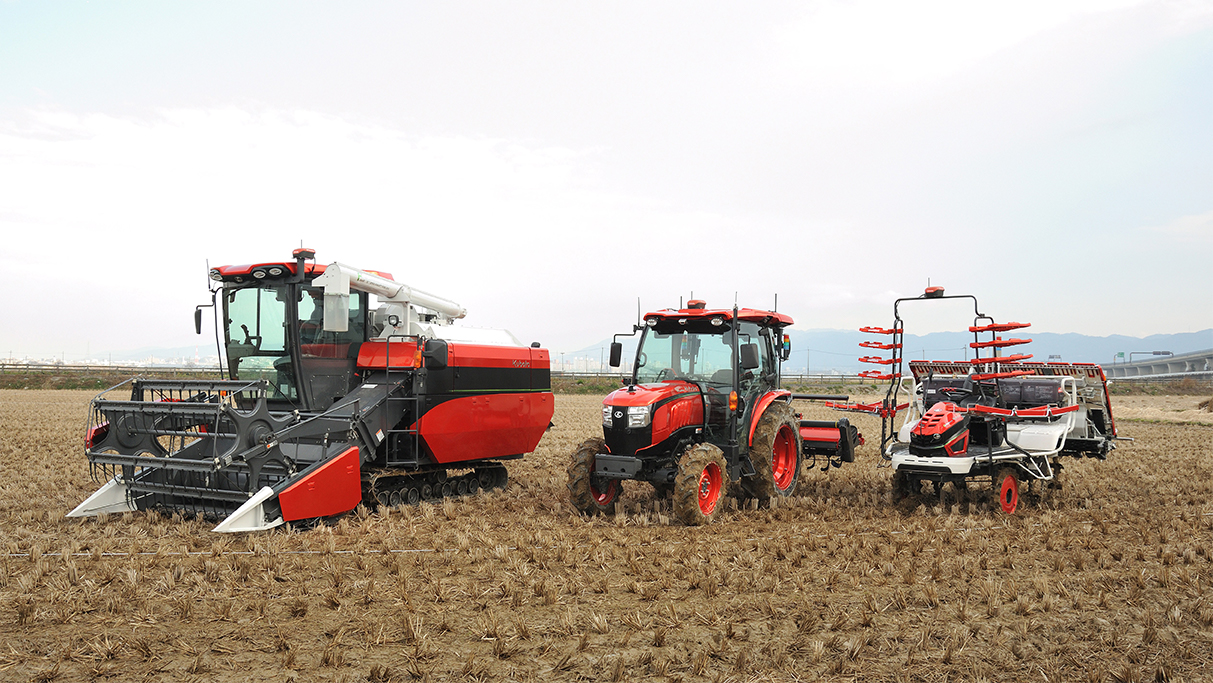First display of autonomous farm machinery — tractor, rice transplanter, and combine harvester
January 25, 2017
At its 2017 New Year Session (product exhibition) held in Kyoto, Kubota Corporation (Head Office: Naniwa-ku, Osaka, Japan; President and Representative Director: Masatoshi Kimata; hereinafter referred to as “Kubota”) gave a preview presentation and demonstration of the company’s autonomous farm machinery now under development. Looking to the future, Kubota will work rapidly to establish such machinery and related technology, pulling ahead of the competition and strengthening the competitiveness of Japanese agriculture.
1. Satisfying the growing need for autonomous farm machinery
- Japanese agriculture is seeing increases in retirement and agricultural outsourcing due to the ageing of the farming population. In turn, this trend is accelerating land consolidation among large-scale farmers, who are generating higher demand for personnel as they expand their operational scales. However, recruitment of seasoned, highly skilled farmers is becoming more difficult because of the decrease in the number of farming households and the ageing of farmers themselves.
- The Basic Plan for Food, Agriculture, and Rural Areas formulated in 2015 likewise calls for reinforcement of technology development with the application of robotics, ICT, and other advanced technologies. Needs are growing for next-generation farm machinery, not only for the securing of farming personnel but also for the achievement of low-cost agriculture.
- In response to the changing agricultural environment, Kubota launched the “Farm Pilot” GPS farm machinery last year. The purpose is to contribute to efforts for higher precision and lower costs with less farming labor through use of a global positioning system (GPS).
- Kubota is working for early establishment of its autonomous technology and stronger linkage of the KUBOTA Smart Agri System (KSAS) with farm machinery. While continuing to pursue development of its original technology in these and other areas, Kubota is planning to swiftly expand its GPS farm machinery lineup.
2. A lively demonstration
- The demonstration was based on the concept of one year of farm work (tilling, planting, and harvesting) making full use of GPS farm machinery.
- The Basic Plan for Food, Agriculture, and Rural Areas formulated in 2015 likewise calls for reinforcement of technology development with the application of robotics, ICT, and other advanced technologies. Needs are growing for next-generation farm machinery, not only for the securing of farming personnel but also for the achievement of low-cost agriculture.
- The demonstration also showed the direction of future development based on linkage of information including KSAS field maps and GPS farm machinery.
3. New machines for new types of work
| Tractor | 60-horsepower class, automatic tilling |
|---|---|
| Rice transplanter | automatic transplanting in eight rows |
| Combine harvester | 100-horsepower class, automatic harvesting |
| Other | Acombined work with an autonomous tractor and vegetable transplanter |
4. Future action
- As the third product in the Farm Pilot Series, Kubota intends to begin trial sales of an autonomous tractor (in the 60-horsepower class) in June 2017.
(The tractor to be sold has partially different specifications in features such as the design of the body from those of the 60-horsepower tractor used in the demonstration this time. In addition, its sales method, sales volume, recommended retail price, and other details have not yet been determined.)
(Reference) Approaches to date
| Farm Pilot Series | Type | Sales launch | Remarks |
|---|---|---|---|
| 1st product: rice transplanter |
EP8D-GS specs | September 2016 | With built-in straight-line keeper function |
| ZP67-GS specs | November 2016 | ||
| 2nd product: tractor |
M7-GF specs | December 2016 | With built-in auto-steering function |
